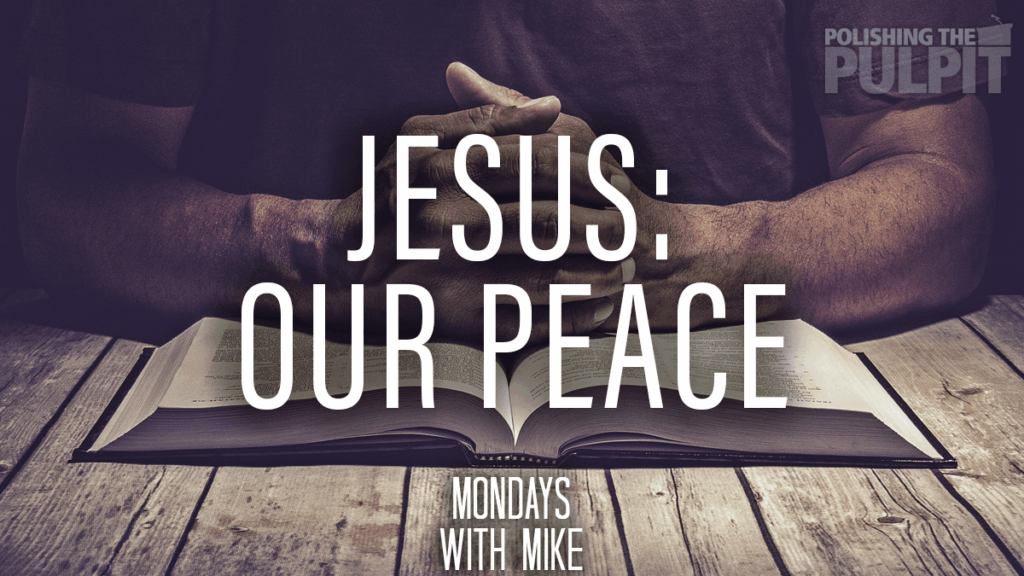For he himself is our peace, who has made us both one and has broken down in his flesh the dividing wall of hostility by abolishing the law of commandments expressed in ordinances, that he might create in himself one new man in place of the two, so making peace, and might reconcile us both to God in one body through the cross, thereby killing the hostility. And he came and preached peace to you who were far off and peace to those who were near. For through him we both have access in one Spirit to the Father (Ephesians 2:14-18).
In five short verses, grand themes such as Christ, the cross, race relations, the taking away of the Old Testament, unity and the removal of hostility, the gospel, the church, reconciliation, access to God and the Trinity all are beautifully and powerfully linked. As crucial as are all these themes, “peace” dominates this passage both explicitly (vv. 14, 15, 17) and implicitly. Here both the horizontal and vertical dimensions of peace are treated within the framework of God’s saving plan in Christ. In this marvelous section, there are four great truths to remember about peace.
Remember the Embodiment of Peace.“For he himself is our peace” (Ephesians 2:14). The personal pronoun “he himself” is at the beginning for the sake of emphasis. The point simply must not be missed; there was hostility but now the One who brought us near is “our peace.” Paul seeks to connect Jesus and peace as comprehensively as possible. Without Jesus, there is no peace.
Remember the Means of Peace. The question now turns to “how.” How did Jesus bring peace to us? The text yields three expressions that provide insight. They are that Jesus “has made us both one” (vs. 14), “has broken down in his flesh the dividing wall of hostility” (vs. 14), and that he has “abolished the law of commandments expressed in ordinances” (vs. 15). Each expression is tremendous in its impact – Jew and Gentile become one, the dividing wall is broken down, the law is fulfilled and done away with and a better covenant has come in Christ (Matthew 26:28; Hebrews 8:6).
Remember the Purpose of Peace. But why? The purpose of Christ’s removing the hostility by bringing to an end the old law was twofold: (1) “To create in himself one new man in place of the two” (vs. 15); and, (2) To “reconcile us both to God in one body through the cross” (vs. 16). It took an act of God for reconciliation to occur! It took the death of Jesus on the Cross (1 Peter 3:18)
Remember the Result of Peace. Verse 18 says, “For through him we both have access in one Spirit to the Father.” Jesus provides us access to God! The result of Christ’s work culminating in the Cross means that the good news of peace can now be proclaimed to all. “Christ is our peace” (2:14), he “made peace” (2:15) and he “preached peace to you who were far off and peace to those who were near” (2:17). How are we to take the beginning of verse 17, “And he came and preached peace”? When did this occur? The most likely option is that it refers to Christ speaking through the apostles by means of the Holy Spirit (cf. 2:20; 3:5). The wording of this passage closely echoes Isaiah 52:7 and 57:19. The “gospel of peace” (Ephesians 6:15) is proclaimed to the “near” (the Jews) and to those “far off” (the Gentiles). The main verb “preached” means “to declare glad tidings” and is used fifty-four times in the New Testament, twenty-one times by Paul, and twice in Ephesians (2:17; 3:8). The corresponding noun, “gospel,” occurs seventy-six times in the New Testament.
The good news of peace in Christ was not to the Jews at the Gentiles’ expense nor to the Gentiles at the Jews’ expense, but for both. Because of Christ’s death and the rich blessings attached thereto, there is a wonderful message of peace and reconciliation that ALL need to hear. The gospel is a message to which ALL need access. Access to God and peace is possible due to Jesus!
Mike Vestal


